Oh boy, here we go. What did I say, huh?
To be honest, I didn't even know people ate mackerel until I moved to the UK. We always just used it for bait to catch blues on the boat I used to work. Anyway.
EU is ready to officially butt heads with Iceland and the Faroe Islands for overfishing mackerel stocks. Both have raised their fishing quotas significantly and have angered fishermen who work the same waters, such as those from Scotland and Norway.
So what exactly is the EU gonna do about it? Great question - doesn't say. It just says there is a mandate to negotiate with the Icelandic and Faroese officials. Negotiations for a long-term deal should resume in October.
Full article here (AFP via Google)
Tuesday, 28 September 2010
Something Completely Silly

image credit BBC
Duh-duh...
So my sister sent me a link yesterday and I was introduced to a show called "Walk on the Wild Side" on BBC One. It has nothing to do with conservation. It has nothing to do with news. It has nothing to do with marine resource management. But it does have some sea creatures in it, so that's enough to post it here, right?
Basically it's animals "talking" over nature footage. This makes me with I had TV...I could seriously watch hours of this - and I did on YouTube yesterday.
Farting Dolphin
Singing Sharks
I couldn't find this one alone, but the Superhero Seal Pups at the end of this video are hilarious.
There's a couple more with some dolphins and an elephant seal, and plenty with other types of animals. I recommend you spend your day being productive and watching all of them.
Link here (BBC)
Monday, 27 September 2010
New Study Measures Nations’ ‘SeafoodPrint’ - Oceana & The Washington Post
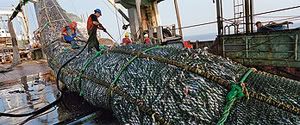
photo credit Jean Gaumy & Magnum Photos
A new study published last week measures different country's "SeafoodPrints" around the world. Think of it like a carbon footprint, only with seafood production instead of carbon production.
"How do you measure the "SeafoodPrint" of a country, you ask? By factoring in the type of fish and the total amount hauled in. The researchers used a unit of measurement based on "primary production," the microscopic organisms at the bottom of the marine food web that are required to make a pound of a given type of fish."
Clever. And needed - I might add. We've been hearing a lot about how fish stocks are declining worldwide. The ocean is in just as much trouble as the rest of the planet - if not more.
China wins (if you want to call it that) first place for its massive SeafoodPrint based on population size. Peru comes in second due to its large anchoveta fishery that provides feed for livestock and farmed fish worldwide. Guess who's number three? The United States - for its terrible choices in preferring top predators like tuna, salmon and swordfish.
"As Dr. Pauly told the Washington Post, "A pound of tuna represents roughly a hundred times the footprint of a pound of sardines.""
So what should we do?
"We could think about reducing our [seafood] footprint like we're thinking of reducing carbon emissions," says National Geographic fellow Enric Sala.
Want more information on choosing sustainable seafood? Check out this post for some great tools, or just stop by your local Whole Foods Market and follow their handy labeling system.
Full articles here (Oceana & The Washington Post)
Sunday, 26 September 2010
Turkey to Eliminate Driftnets in 2011 - Oceana
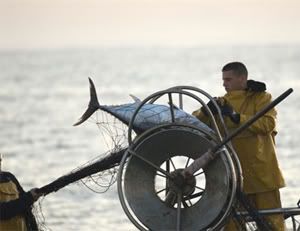
photo credit Oceana & Carlos Suarez
"It’s estimated that thousands of creatures, including whales, dolphins, sharks and sea turtles, are trapped by the indiscriminate fishing gear each year."
And that's a great reason to stop using it. European organizations estimate there are over 500 illegal fishing vessels operating in the Mediterranean - some with driftnets up to 12 miles long! As a result, Morocco recently announced its plans to end the use of driftnets in the Med, and as of Wednesday it was announced that Turkey has jumped on board as well. Great news for countless marine species!
"The UN passed an international moratorium on driftnets 15 years ago, and the EU instituted a ban seven years ago, but many French, Italian and Moroccan vessels have continued using them."
While the news of the upcoming ban falls on grateful ears, laws like this have a history of being ignored and there is potential for legal loopholes. Let's hope the ban gets implemented and supported successfully!
Full article here (Oceana)
Orange Roughy Fishery to Re-Open - Radio New Zealand News
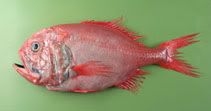
photo credit A. Orlov & FishBase
I smell something fishy...and it's not the fish.
Orange roughy is a conservation-dependant species. That means that unless we're very careful about how many we catch, it's going to go extinct. The orange roughy fishery off South Island, New Zealand closed 10 years ago due to dwindling stocks. Now it is to be opened again.
If you were to walk into your local Whole Foods Market or check out the earlier sustainable seafoods post - or even just Google it, really - you would find that orange roughy is one of the worst choices you could make when purchasing seafood. This ugly little pink fish has unfortunately been found to taste good (I assume, I've never had it as far as I know), and now it's ridiculously overfished to the point where it could be wiped out completely. I still find it shocking that somehow it's okay to eat endangered species from the ocean. You don't go to your local supermarket and pick up tiger steaks, do you?
Anyway. Have the orange roughy stocks really come back enough to re-open fishing? Probably not. And even so, stocks are still in decline in other areas not so far away.
"The Royal Forest and Bird Protection Society of New Zealand says evidence supporting the re-opening is unsound. Spokesperson Kirstie Knowles says it is based on an eight-fold increase in the fish stocks there, which is impossible."
Are we really ready for this?
Full article here (Radio New Zealand News)
Friday, 24 September 2010
Rescuers Scramble to Save Beached New Zealand Whales - Discovery News
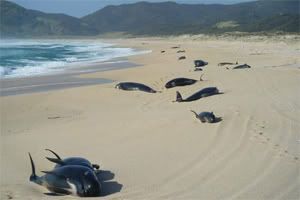
photo credit New Zealand Department of Conservation
A pod of about 80 pilot whales stranded themselves in Spirits Bay, New Zealand Wednesday. Nearly 60 of them were presumed dead as of yesterday. This is the second mass stranding of pilot whales in the area in the past two months.
Full article here (Discovery News)
***UPDATE***
Fourteen whales successfully rescued!
Thursday, 23 September 2010
Heads Up: Are You Unknowingly Eating Shark?
Check out this helpful list from VisionDive compiling lists of false names sharks are served under on menus. Includes English, Spanish, Greek, French, Italian and German.
"Any consumer of shark dishes is directly complicit in the extinction of sharks."
List here (VisionDive)
Want some sustainable seafood alternatives? Check out this post, or visit your local Whole Foods Market!
"Any consumer of shark dishes is directly complicit in the extinction of sharks."
List here (VisionDive)
Want some sustainable seafood alternatives? Check out this post, or visit your local Whole Foods Market!
Whale Fossil Found at San Diego Zoo - LA Times

photo credit Allen J. Schaben & LA Times
Well damn, these things are just popping up all over the place, aren't they?
The San Diego zoo is home to 4,001 animals. That last one? They had no idea about it. It's been dead for 3 million years.
Construction workers were digging a hole for a new storm-water drainage system when they hit something special.
"I just kind of made eye contact with him. He knew right away that I had heard something big," says Gino Calvano, a paleontologist at the San Diego Natural History Museum.
Paleontologists had been on site because it was suspected that during the dig they might uncover shells or shark teeth...but never a whale!
Full article here (LA Times)
Where You Can and Can't Dig at the Beach - BuzzFeed
Alright, so BuzzFeed might be my guilty procrastination pleasure...but sometimes I do find legitimate stuff on there!
Check out this video from ABC News 3 when reporter Dan Thomas tried to build a sandcastle on a Florida beach affected by the BP oil spill.
It's illegal to dig in the sand. Yep. It's illegal to dig in the sand. It's illegal to dig in the sand. Are you serious? Apparently it's also illegal to film in a public park. No home videos, folks. And quit that sand castle nonsense right now.
The federal government has made a law saying BP cleanup workers can't dig more than six inches into the sand...even though in the video you can CLEARLY see oil remains after that depth. They're considering maybe extending that depth to 18 inches. Maybe.
With rules like this, the spill will never be cleaned up. Thanks, Feds.
Video here (BuzzFeed)
Check out this video from ABC News 3 when reporter Dan Thomas tried to build a sandcastle on a Florida beach affected by the BP oil spill.
It's illegal to dig in the sand. Yep. It's illegal to dig in the sand. It's illegal to dig in the sand. Are you serious? Apparently it's also illegal to film in a public park. No home videos, folks. And quit that sand castle nonsense right now.
The federal government has made a law saying BP cleanup workers can't dig more than six inches into the sand...even though in the video you can CLEARLY see oil remains after that depth. They're considering maybe extending that depth to 18 inches. Maybe.
With rules like this, the spill will never be cleaned up. Thanks, Feds.
Video here (BuzzFeed)
Tuesday, 21 September 2010
New Wild-Caught Seafood Sustainability Ratings - Whole Foods
You might have heard by now - and I hope you have. The environmentally-minded grocery chain Whole Foods has committed to phasing out all unsustainable seafood from their stores by Earth Day 2013.
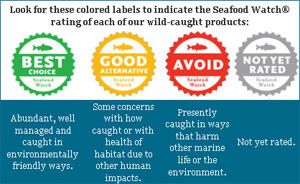
image credit Whole Foods
"Green or “best choice” ratings indicate a species is relatively abundant and is caught in environmentally-friendly ways. Our stores already feature a number of green-rated species. Having green rated species is critical because it demonstrates that fish populations can be healthy and that fisheries can be sustainably managed. Yellow or “good alternative” ratings mean some concerns exist with the species’ status or catch methods; and red or “avoid” ratings mean that for now the species is suffering from overfishing, or that current fishing methods harm other marine life or habitats. We’re evaluating the red-rated fisheries to see if changes can be made to improve fishing practices and ultimately earn a higher rating."
Here's a question: If a fish is rated-red, why continue to sell it? Well, Whole Foods has a pretty good answer:
"Actually, we already stopped selling especially vulnerable red-rated species such as non-MSC-certified Chilean sea bass, orange roughy, bluefin tuna, sharks, and marlins (with the exception of Hawaii-caught blue marlin, sold only in Hawaii stores). Under this new program, all swordfish and tuna from red-rated fisheries will be eliminated from seafood counters by Earth Day 2011. And by Earth Day 2012, all other seafood from red-rated fisheries will be discontinued with the exception of Atlantic cod and sole, which will be sold through Earth Day 2013. In the meantime, we’re evaluating the red-rated fisheries to see if changes can be made to improve fishing practices. Some fishermen have worked with us for many years so it’s a partnership and a process that takes a little time to change."
So, steps have already been made - which is great! It looks like each year on Earth Day the store will be eliminating the next-least-sustainable fish, in a constant movement forward.
This program will compliment the store's already-existing program for labeling farmed seafood, which follow the highest standards in the industry. They also have a partnership with the Marine Stewardship Council (MSC) which is the world's leading certification organization for wild-caught seafood.
This program aims to educate consumers about what they're actually buying, and perhaps to put a little bit of pressure on fisheries to step up their game and create a better, more sustainable product. I think it's great to know exactly what you're buying and exactly where it came from. An educated consumer makes better choices, but as we've seen in the past, trying to choose the best sustainable seafood can be a bit tricky sometimes...Even for someone with a degree in marine biology!
So, cheers Whole Foods. I will definitely be supporting this program. I hope you will too!
Full article here (Whole Foods)
Whole Foods Market website

image credit Whole Foods
"Green or “best choice” ratings indicate a species is relatively abundant and is caught in environmentally-friendly ways. Our stores already feature a number of green-rated species. Having green rated species is critical because it demonstrates that fish populations can be healthy and that fisheries can be sustainably managed. Yellow or “good alternative” ratings mean some concerns exist with the species’ status or catch methods; and red or “avoid” ratings mean that for now the species is suffering from overfishing, or that current fishing methods harm other marine life or habitats. We’re evaluating the red-rated fisheries to see if changes can be made to improve fishing practices and ultimately earn a higher rating."
Here's a question: If a fish is rated-red, why continue to sell it? Well, Whole Foods has a pretty good answer:
"Actually, we already stopped selling especially vulnerable red-rated species such as non-MSC-certified Chilean sea bass, orange roughy, bluefin tuna, sharks, and marlins (with the exception of Hawaii-caught blue marlin, sold only in Hawaii stores). Under this new program, all swordfish and tuna from red-rated fisheries will be eliminated from seafood counters by Earth Day 2011. And by Earth Day 2012, all other seafood from red-rated fisheries will be discontinued with the exception of Atlantic cod and sole, which will be sold through Earth Day 2013. In the meantime, we’re evaluating the red-rated fisheries to see if changes can be made to improve fishing practices. Some fishermen have worked with us for many years so it’s a partnership and a process that takes a little time to change."
So, steps have already been made - which is great! It looks like each year on Earth Day the store will be eliminating the next-least-sustainable fish, in a constant movement forward.
This program will compliment the store's already-existing program for labeling farmed seafood, which follow the highest standards in the industry. They also have a partnership with the Marine Stewardship Council (MSC) which is the world's leading certification organization for wild-caught seafood.
This program aims to educate consumers about what they're actually buying, and perhaps to put a little bit of pressure on fisheries to step up their game and create a better, more sustainable product. I think it's great to know exactly what you're buying and exactly where it came from. An educated consumer makes better choices, but as we've seen in the past, trying to choose the best sustainable seafood can be a bit tricky sometimes...Even for someone with a degree in marine biology!
So, cheers Whole Foods. I will definitely be supporting this program. I hope you will too!
Full article here (Whole Foods)
Whole Foods Market website
Manatee Subspecies Genetically Confirmed, but Diversity Challenge Looms - Science Daily
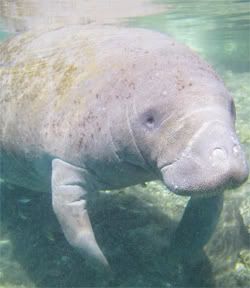
photo credit iStockphoto & Yuko Hirao
It's official - the world now has a newly documented species of manatee - yay! Honestly, who doesn't love these guys?
Manatees living in Florida were genetically compared with those living in Belize, and the two populations were found to be separate genetic subspecies.
But with the good news comes some bad - the newly recognized Belizean subspecies has low genetic diversity. Genetic diversity is important to help stabilize a population should disease or natural disasters sweep through the area the manatees are living in and kill off individuals. A wide range of genes is needed to keep a population healthy and able to breed successful offspring.
So I welcome the newly discovered subspecies to the recognized world...but let's hit the ground running on this one and help pull the Antillean manatees of Belize back to a healthy population!
Full article here (Science Daily)
The Most Beautiful Crabs In The World - BuzzFeed
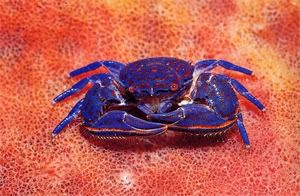
photo credit BuzzFeed
so probably Wikipedia
Just for fun. :)
Not really news, but why not share some pretty little invertebrates in the spotlight for a change?
Photos here (BuzzFeed)
Enjoy!
Deepwater Horizon: The End of the Beginning - Nature
Ding dong, the well is dead. It's a relief, but it's definitely not over - although people would love to think so. As time has gone on from the day of the explosion, less and less news sources have been covering the event, and it's been difficult to find articles that continued to focus on the environmental tragedies rather than the business ones. But anyway, here we are today. As of 18 September, the well is sealed.
“We can finally announce that the Macondo 252 well is effectively dead,” said the National Incident Commander, Admiral Thad Allen. “Additional regulatory steps will be undertaken but we can now state, definitively, that the Macondo well poses no continuing threat to the Gulf of Mexico.”
No continuing threat - but the oil that's already there will still present a problem for years to come. "The End of the Beginning" is very appropriate.
Full article here (Nature)
“We can finally announce that the Macondo 252 well is effectively dead,” said the National Incident Commander, Admiral Thad Allen. “Additional regulatory steps will be undertaken but we can now state, definitively, that the Macondo well poses no continuing threat to the Gulf of Mexico.”
No continuing threat - but the oil that's already there will still present a problem for years to come. "The End of the Beginning" is very appropriate.
Full article here (Nature)
Wednesday, 15 September 2010
Vladimir Putin Shoots a Whale - MNN
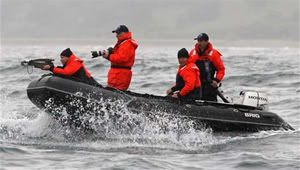
photo credit Alexei Druzhinin & AP
I must reference this picture as my reaction to the headline.
Putin has been very busy recently being awesome:
"...He's shot a Siberian tiger with a tranquilizer dart, ridden bare-chested on a horse, captured a polar bear alive to fit it with a tracking collar, and even flew in a tanker plane dropping water on a Russian wildfire."
And all in the name of good. Aww, Vlad...and people say you're a sketchy guy.
Most recently he helped marine biologists take a skin sample from an endangered grey whale for research. How? With a fuckin' crossbow.
Why?
"Because I like it. I love the nature."
What a ham. But good work, Mr. Putin.
Full article here (MNN)
First Hourglass Dolphin in 150 Years Found on New Zealand Shores - TreeHugger
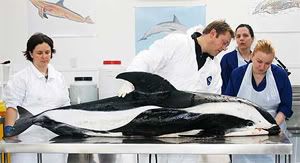
photo credit Massey University
Isn't it beautiful? Too bad it's dead :(
Typically these dolphins swim off the shores of Antarctica, and are very rarely seen north into the waters of New Zealand. Not much is known about this pretty dolphin. Having one wash up - although sad - will allow scientists to fill in missing information about these guys.
Full article here (TreeHugger)
Tuesday, 14 September 2010
Titan of the Thames: Resurfacing after 200 Years, the Whale that met a Bloody End - The Daily Mail
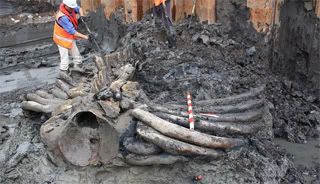
photo credit The Daily Mail
Right here in the middle of London, a 200 year old skeleton of an Atlantic Right Whale has been discovered in the Thames. South-East London used to be home to a large whaling port.
The head was missing - thought to have been taken inland in order to harvest the baleen for corsetry.
The skeleton is going on display at the Museum of London, and will later move to the Natural History Museum for further research.
Atlantic right whales are now an endangered species. There could be as few as 300 remaining today.
Full article here (The Daily Mail)
Scientists Investigate Massive Walrus Haul-Out in Alaska - The Guardian
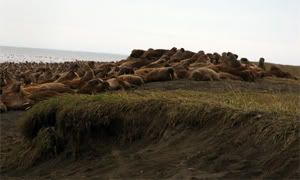
photo credit USGS
Until now, walruses have hauled-out to rest on ice. But this year in Alaska they have been spotted on dry land.
"It's something that we have never seen before in this area," said Geoff York, of the WWF's global Arctic programme. "As the ice decreases, the walrus are abandoning it earlier and earlier. They are having to swim ashore, or to linger on less suitable drift ice for long periods of time."
The walrus has a 40% chance of extinction by 2095 because of climate change and reduced sea ice in the summer months, which is primarily where the animals live and rest.
When the walruses are forced to come on to dry land, there is an increased risk of being trampled by each other - especially young calves.
"The Arctic is warming at twice the rest of the world on average, and its seas are growing increasingly acidic because of increased concentrations of carbon dioxide."
This is also bad news for the walrus' food source. They forage on shellfish, whose calcium-carbonate shells are corroded away by the rising acid concentration in the sea.
Says Rebecca Noblin, the director of the Centre for Biological Diversity, "Unless we dramatically reduce our greenhouse emissions, the walrus is on a trajectory toward extinction."
Full article here (The Guardian)
Plastic Bag found Floating near Titanic Shipwreck - MSNBC
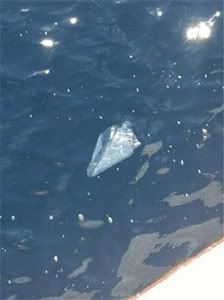
photo credit OurAmazingPlanet
"When oceanographer David Gallo stepped out onto his ship, floating above the resting place of the RMS Titanic, he spotted evidence of a different kind of tragedy — a lone plastic bag floating in the water.
"I walked out on the deck to appreciate a calm blue sea and there it was," said Gallo, of the Woods Hole Oceanographic Institution (WHOI) in Massachusetts. "It was totally unexpected and it had a profound impact on those of us on deck.""
It really is sad, the impact that human waste is having on the natural environment - even when you think you're in the middle of nowhere.
""We look at Titanic as the greatest disaster at sea, but the Titanic was a single tragic event. What we are doing to the sea on an everyday basis is one of the great untold tragedies," Gallo told OurAmazingPlanet."
It's not just the visible plastic that's scary; it's the bits and pieces broken down over time that enter the food chain. Each step upwards in the chain accumulates more and more plastic particles, ending ultimately in large predators - humans included.
Full article here (MSNBC)
Sunday, 12 September 2010
Ancient Whale Skull Found in Calvert Cliffs - The Baltimore Sun
A whale skull has been exposed in the Calvert Cliffs in Maryland. The cliffs are often a site for these kinds of discoveries, and typically the Calvert Marine Museum collects three or four whale skeletons from the area per year.
"Only a small portion of the back of the skull is visible, said Stephen Godfrey of the Calvert Marine Museum in Solomons. But the Miocene-era fossil is probably 16 million years old, and likely belongs to an extinct family of small whales that swam in what were then Atlantic coastal waters teeming with marine life."
It is a smaller specimen, probably similar in size to today's minke whales.
The skull was discovered several months ago, but the excavation site was unstable and it could not be properly removed. Scientists covered the visible portions to protect it from amateurs, but when the skull was exposed again they decided to step in, stabilize the area and go ahead and remove the skull from the cliffs. Students from a Harrisburg, Pennsylvania university are helping with the dig.
"It's well and good to learn about evolution and read about it in a book," says Professor Robert E. Furey of the Harrisburg University of Science and Technology. But "when you go and remove the remains of animals this size, and see how much ground has been laid down on top of it, and how old it is, it brings home the concepts of evolution and deep time. I'm hoping they have some sort of epiphany."
Whales have not yet been found this far down in the cliff sediments, so it is possible that this will be the first specimen found of its kind.
Full article here (The Baltimore Sun)
"Only a small portion of the back of the skull is visible, said Stephen Godfrey of the Calvert Marine Museum in Solomons. But the Miocene-era fossil is probably 16 million years old, and likely belongs to an extinct family of small whales that swam in what were then Atlantic coastal waters teeming with marine life."
It is a smaller specimen, probably similar in size to today's minke whales.
The skull was discovered several months ago, but the excavation site was unstable and it could not be properly removed. Scientists covered the visible portions to protect it from amateurs, but when the skull was exposed again they decided to step in, stabilize the area and go ahead and remove the skull from the cliffs. Students from a Harrisburg, Pennsylvania university are helping with the dig.
"It's well and good to learn about evolution and read about it in a book," says Professor Robert E. Furey of the Harrisburg University of Science and Technology. But "when you go and remove the remains of animals this size, and see how much ground has been laid down on top of it, and how old it is, it brings home the concepts of evolution and deep time. I'm hoping they have some sort of epiphany."
Whales have not yet been found this far down in the cliff sediments, so it is possible that this will be the first specimen found of its kind.
Full article here (The Baltimore Sun)
UK Trawler Filmed Dumping Tonnes of Fish - The Guardian
Okay, this is an older video, but I was just SHOCKED when I saw it - and I have to share. I knew this was going on, but I've never actually seen it before. So much waste, so much death for no reason. How can these people sleep at night? It's not news that the fisheries are severely declining. This has been going on for a while now.
I really just hate humanity sometimes.
In the video, a British fishing boat is seen dumping literally tons of fish overboard as waste. It's really upsetting. But it's better to open our eyes and see than it is to look the other way.
Video here (The Guardian)
I really just hate humanity sometimes.
In the video, a British fishing boat is seen dumping literally tons of fish overboard as waste. It's really upsetting. But it's better to open our eyes and see than it is to look the other way.
Video here (The Guardian)
Saturday, 11 September 2010
Dolphin Innovators Hunt Fish by Collecting Conch Shells - BBC
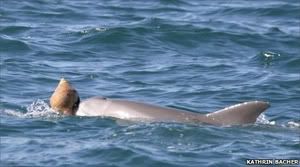
photo credit Kathrin Bacher
First of all, that picture is adorable.
The clever dolphins of Shark Bay, Australia have been collecting seashells. Why? They've figured out their fishy prey will hide in the empty shells, so the dolphins bring them to the surface where they can easily be flushed out and eaten.
""Shark Bay dolphins are known as clever inventors, showing a remarkable range of foraging tactics, which are unprecedented in other cetacean populations," says biologist Dr Michael Krützen of the University of Zurich, Switzerland."
The dolphins of this area are also known for other inventive foraging techniques, including "sponging" - where a dolphin will grab a piece of sea sponge and use it as a "glove" over their snouts to protect themselves from stinging fish while searching the sand for food.
Bringing shells to the surface appears to be a relatively new behaviour on the dolphin's part. Sponging has been culturally passed down from generation to generation for some time, but there is no evidence of younger dolphins being taught the conch technique...yet!
Full article here (BBC)
Wednesday, 8 September 2010
Trash on the Spin Cycle - PBS
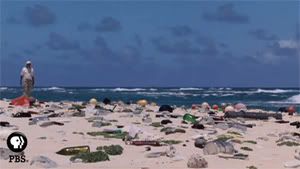
image credit PBS
This is a short video featuring Jean-Michel Cousteau speaking about ocean debris and the Great Pacific Garbage patch. It's really sad, some of the things going on here.
Cousteau is in the Hawaiian Islands (That's right, this is in America, people. Not some far-off distant land), where literally tons of garbage wash up from our disposable lifestyle.
"About 80% of this debris comes from land; it makes its way into storm drains, then rivers, then travels down our watersheds into the ocean."
What's worse is that the islands are nesting grounds for many important seabird species. The adults often mistake tiny plastic particles for food and will consume them, filling their bellies with non-digestibles so that the birds will feel full and stop eating, but in reality will actually be starving themselves to death. When the chicks hatch, the parents feed the plastics to their young.
In the video you can see piles of bird bones surrounded by tiny plastic particles. Cousteau even flips over a dead bird, and you can see the plastic falling out of its rotted stomach.
"We need to do better than this," he says. "It is our problem, and it is our problem to solve."
Video here (PBS)
See recent post about the Atlantic Garbage Patch
***UPDATE***
DOH! I almost forgot!!
I wanted to link you to an awesome post I saw yesterday about what to do with all your plastic shopping bags you have hanging around. Check it out!
(Buy me that first new-bag made out of old-bags.)
Killer Whale Dies at SeaWorld in San Diego; Orca Shows Canceled - LA Now
More bad news for SeaWorld...maybe it's time to take a serious look at what you're doing...?
Twelve-year-old male Sumar died of unknown causes yesterday. Six whales remain at the park.
"The male orca began acting lethargic on Monday and was given antibiotics by park veterinarians. But his condition worsened and he died at about 1:45 p.m. A necropsy is planned."
But fear not, 'cuz the shows will resume today! No sympathy, these people...Just money money money. Disgusting.
Full article here (LA Now)
Twelve-year-old male Sumar died of unknown causes yesterday. Six whales remain at the park.
"The male orca began acting lethargic on Monday and was given antibiotics by park veterinarians. But his condition worsened and he died at about 1:45 p.m. A necropsy is planned."
But fear not, 'cuz the shows will resume today! No sympathy, these people...Just money money money. Disgusting.
Full article here (LA Now)
Pictures: Crab Swarms Overtake Island—Mystery Solved - National Geographic
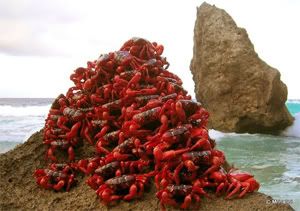
photo credit Mrinalini, Bangor University
Well, isn't that picture just adorable? I think they're just the cutest things.
For a long time scientists have wondered how the normally sedentary little crabs have been able to undertake "one of the most arduous migrations on Earth." Now we know.
Every year millions of the bright red crabs march down from a high rainforest plateau to the shores of the Indian Ocean to mate. You might have seen clips of this on BBC or Animal Planet shows before - it's really quite a lot of crabs! Usually these guys are pretty lazy.
""It's an amazing feat—going from not being able to exercise for more than ten minutes to walking for several miles," said Turner, a biologist at the University of Bristol in the United Kingdom."
Turns out a huge spike in the crustacean hyperglycemic hormone "works with glucose, an energy-producing sugar, to fuel the epic trek."
Sugared crabs. Who woulda thunk?
Full article (and some glorious photos!) here (National Geographic)
Tuesday, 7 September 2010
Government Supports Dolphin Ban - SAFE
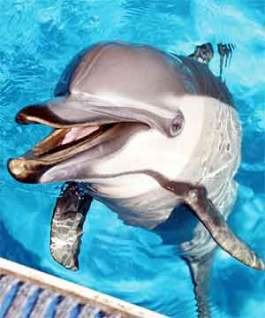
photo credit SAFE
"After spending over three decades imprisoned inside a small concrete pool Kelly, Marineland's 38-year-old performing dolphin, died last Thursday. Her death marks the end of a sad era in New Zealand's history. Kelly was the last surviving captive dolphin in New Zealand. SAFE will now take action to ensure it never happens again."
Seventy-one dolphins have died in captivity in New Zealand alone. Kelly's death signaled that it was time for a change in the Marine Mammal Protection Act (MMPA).
"A coalition between SAFE, WSPA, the Whale and Dolphin Conservation Society and Project Jonah has received a favourable response from the government to no longer keep dolphins in captivity in New Zealand."
The evidence is strong in showing that concrete pools do not equal vast ocean environments. Recent attention thanks to film The Cove and new TV series Blood Dolphins has heightened public awareness to the cruelty of capture and containment of these intelligent species.
Full article here (SAFE)
Monday, 6 September 2010
The Ultimate Sustainable Seafood? - Chow

photo credit NOAA
"At Miya's Sushi in New Haven, Connecticut, Chef Bun Lai serves European flat oysters with Sichuan pepper, lime, soy, and daikon relish; grilled moon snails; batter-fried Asian shore crabs; and raw slices of lionfish with sake-soy sauce, roasted seaweed flakes, toasted sesame seeds, and chives. It might be the only menu of its kind in the country: He calls it the Long Island Sound Invasive Species Menu."
Well if that doesn't give me a reason to visit my hometown...I've been meaning to try lionfish. But I just adore moon snails - I could never.
We've all been hearing a lot about the decline of popular commercial fish species such as tuna, salmon and cod while invasive species such as lionfish and Asian carp explode and cause problems such as feeding off the young of many more vulnerable species. Some believe it would be a great solution to switch and eat the invasive, overpopulated species instead. Hmm...
Lionfish has been gaining popularity recently, as people have been discovering it's actually quite delicious. The set back is those huge beautiful spines that give them their name. Get stuck by one and you'll be feeling it. For this reason fishermen don't typically bring them in to shore.
Another fish to go from pesky pest to delicious dining is the Asian carp. Although it has been found hard to fillet - and as a result is expensive - the fish has been successful when served at restaurants and is already being exported as food to China. America - hang on to some! Cook up some fish!!
There is a concern that in fishing for an invasive species, it too will actually become overfished and eventually endangered.
"It seems impossibly far off to think that the supply of Asian carp could run out, but what if it does and there is still money to be made and stomachs grumbling for it? Would the fish be farmed? And escape? Again? "Then we have the problem all over," Chef Phillip Foss says."
What do you think? Is eating invasive fish species the ultimate sustainable seafood?
Full article here (Chow)
Man Planned to Eat Washed-Up Whale Tail - News.com.au
More weird whale news.
A man in Florida who found a dead whale washed up on the beach used his fishing knife to chop off the animal’s tail and TOOK IT HOME TO EAT IT.
"I'd probably broil or fry it," said Chris Hogan, the discoverer.
What is going on in the world? Seriously.
"Police detained Mr. Hogan, and another man, for questioning, explaining that mutilating a federally protected species is illegal, even if the animal is found dead."
Sheesh.
Full article here (News.com.au)
A man in Florida who found a dead whale washed up on the beach used his fishing knife to chop off the animal’s tail and TOOK IT HOME TO EAT IT.
"I'd probably broil or fry it," said Chris Hogan, the discoverer.
What is going on in the world? Seriously.
"Police detained Mr. Hogan, and another man, for questioning, explaining that mutilating a federally protected species is illegal, even if the animal is found dead."
Sheesh.
Full article here (News.com.au)
Stranded Whale goes Out with a Bang - The Sydney Morning Herald
"Explosives have been used to euthanase a sickly humpback whale which washed up onto a sandbar off Western Australia's southwest coast."
Um...WHAT?! Am I reading this right?
The DEC was going to let the animal die of natural causes, but instead decided to BLOW IT THE HELL UP.
This is ridiculous.
"In a statement, DEC Albany district manager Mike Shepherd said the whale had moved a couple of metres from its original position, which was enough to stabilise the whale and kill it humanely."
I dunno about you, but I don't really consider dynamite "humanely."
Don't these people know what happened during the last attempt blow up a whale?
Full article here (The Sydney Morning Herald)
Um...WHAT?! Am I reading this right?
The DEC was going to let the animal die of natural causes, but instead decided to BLOW IT THE HELL UP.
This is ridiculous.
"In a statement, DEC Albany district manager Mike Shepherd said the whale had moved a couple of metres from its original position, which was enough to stabilise the whale and kill it humanely."
I dunno about you, but I don't really consider dynamite "humanely."
Don't these people know what happened during the last attempt blow up a whale?
Full article here (The Sydney Morning Herald)
Sunday, 5 September 2010
With Biggest Salmon Run in nearly a Century, Hope Returns to the Fraser - The Globe and Mail

photo credit Andy Clark & Reuters
Mmmmm...salmon. My favourite fish! So light, so smooth and creamy. So wonderful to have a big pinky-orange chunk of fresh raw salmon with nothing else to taint the flavour. Oh god. The days I eat salmon are the better days of my life.
But all is not well in salmon world, and I fear that I may not be able to enjoy this meal in good conscience mush longer. I have already given up tuna, swordfish and Chilean and Mediterranean sea bass for this reason. Please don't take away my salmon...
There may be hope.
"Federal Fisheries Minister Gail Shea has been in B.C. this week and said the excitement she’s seen in fishing communities is palpable. “Everybody is abuzz about the great return of the Fraser sockeye,” she said in an interview on Tuesday."
The new estimates put the total number of salmon coming to the Fraser at 25 million. That makes it the best run since 1913!
But that doesn't necessarily mean we're out of the woods yet. Scientists and fishermen alike were expecting this year to be a peak - just not this mush of one. After this year, salmon numbers are expected to fall again.
“We’re thrilled the numbers are so great, but the reality is 2009 was a problematic year,” she said. “We’ll take into account the great numbers this year, but there are still a lot of questions around the long-term sustainability of Fraser River sockeye.”
Full article here (The Globe and Mail)
The Gulf Spill Cocktail

photo credit Liquor Snob
Is it too soon for this? I had to share.
I found this here while Stumblin' around the web, but it's actually a great marine bio blog too. Here's the recipe:
"GULF SPILL
1.5 Blueberry juice oz
.5 oz Kahlua
.5 oz Chocolate liqueur (I prefer Godiva)
3 Blueberries
Sand colored sugar, like raw or demerara
optional:
Bar spoon chocolate sauce to make extra chocolatey! If you're an addict, and chocolate is your poison, might I suggest CHOCAGAVE. This stuff is amazing and sort of healthy (considering that it is chocolate sauce!)
Rim the glass with sugar that will symbolize sand.
Shake all ingredients over ice and strain into glass.
Float blueberries on top to symbolize dead sea creatures.
Cheers!"
Personally, I think the blueberries look more like tarballs, which is a nice touch.
Will I be trying this? Maybe, if I can afford the ingredients. (hah!)
DeepSeaNews put it best: "Sometimes you have to laugh so you don’t cry."
Link here (Liquor Snob)
Ocean Garbage Patch Not Growing—Where's "Missing" Plastic? - National Geographic
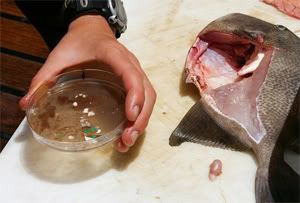
photo credit David M. Lawrence, SEA
Well that picture about sums it up.
At first it seems that the patch not growing would be good news.
"It's possible some of the trash is just too small for researchers to catalog, study leader [Kara Lavender] Law said: "Our net only captures pieces larger than [a third of a millimeter] in size, and it's certain that the plastic breaks down into pieces smaller than that.""
That, and the fact that marine animals have been mistaking the tiny plastic pieces for food. The triggerfish in the photo had 47 pieces of plastic in its stomach! This wasn't in the article, but I've heard stories more than once about seabirds scooping up mouthfuls of plastic mistaken for food. Their bellies become full with tiny plastic pieces, so they think they're full, but they actually starve to death. It's a very sad situation.
This garbage patch probably isn't the one you've heard of. This one is in the Atlantic - not the Pacific which has been getting much attention recently. The scary thing about the Atlantic garbage patch is that scientists can't find the edges.
"Meanwhile, even though the SEA expedition traveled a thousand miles (1,609 kilometers) east of Bermuda, "we still can't find the eastern edge" of the patch, Law said.
The Algalita mission traveled much farther east, all the way to the Azores islands off Portugal (map), the foundation's Eriksen said, and "we had plastics in our samples from Bermuda to the Azores."
Overall, the results tell "a depressing story, to be honest," SEA's Law added. "You're like, Great, [the patch] is not increasing! But I'm sure it is.""
Full article here (National Geographic)
Thursday, 2 September 2010
Dolphin Hunt Kicks Off In Japan - Ecorazzi

photo credit SaveJapanDolphins.org
Yesterday was the first day of the annual dolphin hunt in Taiji - the subject of the film "The Cove." How many dolphins were caught? None!
That's right, in a happy victory of dolphin over dunce, not a single dolphin was caught for the start of the slaughter.
Originally, there was a protest scheduled for yesterday in Taiji, but it had to be cancelled due to threats of violence against the activists.
"Regarding his decision not to protest in Taiji, O’Barry wrote on his blog: “Our work in Japan has never been about confrontation. We believe we are making progress by bringing the truth to the people of Japan about the dolphin slaughter and about mercury-poisoned dolphin meat in markets. We will not play the game that the nationalist groups want us to play – we will not have it become “us versus them”, a battle between dolphin hunters with their militant nationalist supporters and the foreigners who want to ruin Japan’s culture.”"
Unfortunately, ten dolphins were not so lucky today. To learn more about the Taiji dolphins and how you can help, click here.
Full article here (Ecorazzi)
Wednesday, 1 September 2010
Kindai Bluefin Tuna, Farmed Sustainably, Available in Philadelphia - The Philadelphia Inquirer
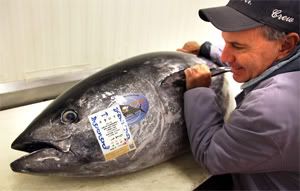
photo credit Laurence Kesterson
Well damn, and we were told it couldn't be done.
""All populations of bluefin tuna are being caught faster than they can reproduce," according to Monterey Bay Aquarium's Seafood Watch."
But the people love tuna. So what will be done about a favourite sushi menu item? Well, Japan's Kinki University's Fisheries Laboratories might just have an answer.
"Kindai tuna are farmed, rather than ranched: raised to maturity from wild bluefin eggs, which ensures genetic diversity. Mediterranean, South Australian, and Mexican tuna ranchers capture juvenile fish, raise them in net pens, and often ship them to market before they are mature enough to reproduce. Critics say ranching doesn't help rebuild stocks, though the higher prices they fetch help fishermen."
Mmkay, some input. Ideas to stop the over-harvesting of bluefin tuna: great. Farming fish: potentially good, depending on how you manage your wastes and ensure genetic diversity. The fact that these are wild eggs is a plus. Pen-raised fish: probably bad, as it leads to a lot of waste creation and potentially stressful living conditions for the fish. Sending them to market before they reproduce: probably good, since the genetic diversity won’t be impaired after years of breeding the same stock of fish over and over again. Will this restore stocks? No, but I don't think that's the point. I think the point is to take the stress off removing wild tuna from the environment, and this will do that.
Is this the end-all of the bluefin tuna debate? No. But I think it's a step in the right direction.
Want more information about choosing a sustainable fish? Check out the post on sustainable seafood!
Full article here (The Philadelphia Inquirer)
Beluga Whales to Gain New Protection Zone - The Globe and Mail

photo credit The Canadian Press
Canada has set aside three areas in the arctic as the new Tarium Niryutait Marine Protection Area. It is the first of its kind in this area.
Beluga whales will be the stars of the new reserve, as the area is home to one of the world's largest populations during the summer months. The whales come here to socialize, feed and raise their calves.
The protected area will also cater to the Inuvialuit culture, which relies on traditional hunting and fishing.
Full article here (The Globe and Mail)
Japan Invites Pro-Whaling Nations to Meeting Focused on Ending Ban on Commercial Hunts - The Canadian Press
Trouble in the air. Japan's strong desire to lift the ban on commercial whale kills seems to be leading to a potentially dangerous gathering.
"The meeting is intended to build solidarity among pro-whaling nations in support of "sustainable use" and to strengthen the lobby against the ban on commercial whaling in place since 1986, the fisheries agency said in a statement."
You all know my opinion on this already, but I'll say it again. I just want to re-state the cruelty involved in whale hunts. Death is often slow and painful for meat that often goes unused. The truth is that since the Second World War, the people of Japan really haven't been eating much whale. It's mostly just a delicacy for wealthy businessmen. They're not trying to preserve their culture, they're not trying to feed their people, they're just trying to make money off a cruel practice. And still, now isn't the time to be hunting whales. Although it may seem like a long time ago, whale populations are still recovering from the last hunts. Re-opening commercial whaling would just start the same series of problems all over again. Most of the world knows this by now, so I don't even know why we're talking about it.
Full article here (The Canadian Press)
"The meeting is intended to build solidarity among pro-whaling nations in support of "sustainable use" and to strengthen the lobby against the ban on commercial whaling in place since 1986, the fisheries agency said in a statement."
You all know my opinion on this already, but I'll say it again. I just want to re-state the cruelty involved in whale hunts. Death is often slow and painful for meat that often goes unused. The truth is that since the Second World War, the people of Japan really haven't been eating much whale. It's mostly just a delicacy for wealthy businessmen. They're not trying to preserve their culture, they're not trying to feed their people, they're just trying to make money off a cruel practice. And still, now isn't the time to be hunting whales. Although it may seem like a long time ago, whale populations are still recovering from the last hunts. Re-opening commercial whaling would just start the same series of problems all over again. Most of the world knows this by now, so I don't even know why we're talking about it.
Full article here (The Canadian Press)
EU Overfishing Charges 'Preposterous': Iceland - AFP

photo credit AFP
The European Union is threatening Iceland with sanctions on the grounds that the country is overfishing mackerel.
"According to international laws, we as a coastal country may fish in our jurisdiction so it is absolutely preposterous of the EU or its member countries to make such threats," says Jon Bjarnason, Fisheries Minister.
"The Nordic island nation has unilaterally decided to raise its mackerel quota to 130,000 tonnes this year compared to the usual 2,000 tonnes agreed upon in an accord with the EU, the Faroe Islands and Norway in 1999."
Yes, Iceland, you have a right to fish in your own waters, but damn that's a huge increase! Be careful...
"Scottish and Norwegian fishermen are particularly angered by what has been described as a "mackerel war.""
This wouldn't be the first time. Here's a bit of a history lesson: Iceland has great fishing grounds. Nice cold waters and a big coastline all the way around, pretty much right in the middle of the North Atlantic. The rest of Europe has known this for a long time, and they've always wanted in. There were three "cod wars" between Iceland and Britain in the 50s and 70s - disputes over territorial waters. This resulted in a bunch of nets being cut, ships being rammed - even shots being fired - and a general feeling of hostility between neighboring fishing countries.
It could happen again, and it looks like it might. When the resources start disappearing, the people will start to fight over them.
Full article here (AFP)
***UPDATE***
I almost forgot...a book recommendation! For more information about the Cod Wars, pick up Cod: A Biography of the Fish That Changed the World by Mark Kurlansky. A great read! I'm actually going to go through it again with a highlighter.
DNA Gathering Development a Blow to Japan's Whaling 'Science' - The Australian
Again, with the quotes around "science." I just love that, such a nice touch. You ain't foolin' no one, Japan.
So, Japan says whales need to be killed in order to be studied, which is crap because other nations study whales and dolphins just fine while keeping them alive. Just like any other animal, just like people as well. Anyway.
A new method, called "blow-sampling," allows scientists to get DNA information without killing the animal of interest. It works by capturing the air and spit exhaled by the whales as they come up for air, which if you've ever been in a basic genetics class, you know you can get the equivalent of cheek cells and all that good stuff in it. Isn't bio fun?
Scientists have been using dart methods that remove a small piece of skin from the animal for a while now, though...So it's not like we needed a new reason not to kill whales. But here you go, here it is anyway!
Full article here (The Australian)
So, Japan says whales need to be killed in order to be studied, which is crap because other nations study whales and dolphins just fine while keeping them alive. Just like any other animal, just like people as well. Anyway.
A new method, called "blow-sampling," allows scientists to get DNA information without killing the animal of interest. It works by capturing the air and spit exhaled by the whales as they come up for air, which if you've ever been in a basic genetics class, you know you can get the equivalent of cheek cells and all that good stuff in it. Isn't bio fun?
Scientists have been using dart methods that remove a small piece of skin from the animal for a while now, though...So it's not like we needed a new reason not to kill whales. But here you go, here it is anyway!
Full article here (The Australian)
Mangrove Forest Inventory Shows Steep Declines - Our Amazing Planet
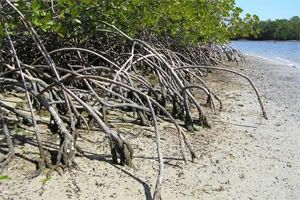
photo credit NPS
A new map made from satellite data shows the world's mangrove forests are far smaller than previously estimated. Only about 6.9% of them are currently protected.
Mangroves are amazingly important plants. Trees, palms and shrubs of the species have evolved to live in the harsh environmental conditions of extreme salinity, high temperatures and substantial tidal differences. The intricate root systems help to slow turbulent waters and keep sediments in place. For these reasons they are an important nursery for young marine life and are also a front-line defence during hurricanes, tropical storms and other sources of beach and island erosion.
I spent some time in Belize in college, and one of our guides explained to us that a lot of rich foreigners came into the cayes to buy private islands. They found the mangrove trees that lined the islands unattractive and had them removed, thus removing the island's natural protection. These islands no longer exist, because without the mangroves to hold everything together, the islands were literally swept away!
"It is believed that 35 percent of mangrove forests were lost from 1980 to 2000," says Chandra Giri, of the U.S. Geological Survey, "which has had an impact on the coastal communities that use mangrove forests as a protective barrier from natural disasters, such as hurricanes and tsunamis."
Full article here (Our Amazing Planet) - Click to see the map generated by the satellites!
Massive Artificial Reef Grows like Wild - Sign On San Diegeo
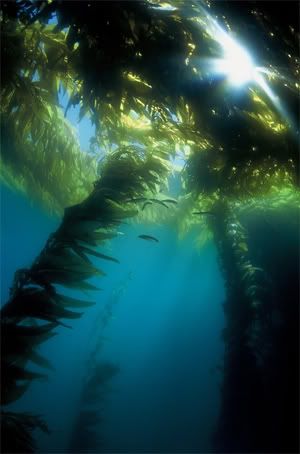
photo credit Southern California Edison
The Wheeler North Reef was put in place by Southern California Edison, San Diego Gas & Electric Co. and Riverside. Their nuclear generating station in North County caused large-scale ecological damage after its erection in 1974.
The permit they held was re-evaluated to make up for the losses suffered due to the plant. The companies had to restore the San Dieguito marsh, finance a marine fish hatchery and construct an artificial reef to replace lost kelp beds.
"The new reef is north of the nuclear plant near San Clemente. It started in 1999 as a 22.4-acre experimental project designed to guide construction of a larger reef."
The foundation of the reef is made of a single layer of medicine-ball-sized boulders across the sand. At this size they will be moved about by passing storms and the ecosystem will be dynamic.
“To get giant kelp coming back generation after generation, there always needs to be bare rock on the reef, and you are only going to get that if you have an unstable reef,” says David Kay, head of environmental projects for Edison.
So far, so good. The reef now spreads 174-acres and the kelp beds are back and strong.
"“We are really well on the way to having duplicated a very complex ecosystem on a large scale,” said Kay.
The growing reef has passed nine of 14 important benchmarks and remains on a positive trajectory. Congrats!
Full article here (Sign On San Diego)
Subscribe to:
Posts (Atom)